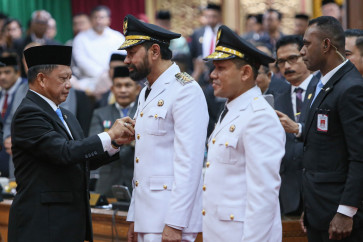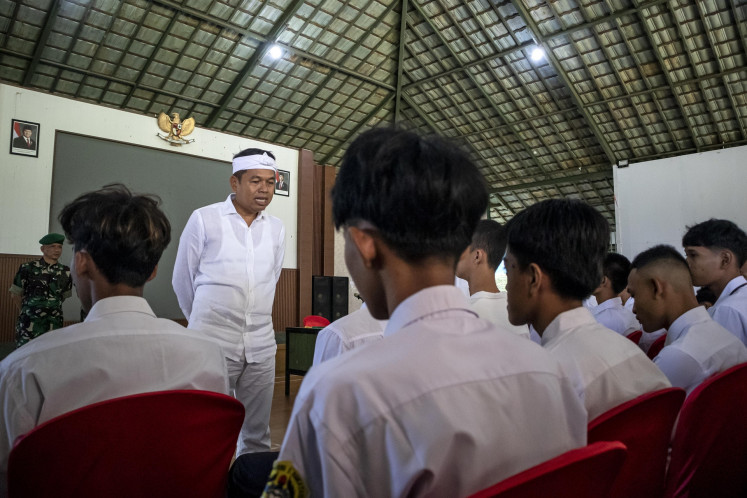400,000 liters of clean water distributed on drought-hit Palue Island
The disaster mitigation agency of Sikka regency in East Nusa Tenggara (NTT) distributed some 400,000 liters of clean water recently to people in eight villages on Palue Island, one of the areas in the regency that has been experiencing drought for the last few months
Change text size
Gift Premium Articles
to Anyone

T
he disaster mitigation agency of Sikka regency in East Nusa Tenggara (NTT) distributed some 400,000 liters of clean water recently to people in eight villages on Palue Island, one of the areas in the regency that has been experiencing drought for the last few months.
The eight villages were Kesokoja, Ladolaka, Lidi, Maluriwu, Nitunglea, Reruwairere, Rokirole and Tuanggeo.
The prolonged dry season has caused more than 10,000 people on the island to exhaust the rainwater collected in their reservoirs. The situation has forced them to buy water and to do so they have to cross the sea to get to nearby Flores Island.
Linda Wea of Nangaliwu hamlet in Lidi village confirmed that the drought made rainwater reservoirs on the islet run dry. This forced people in the region to rent motorboats to buy water in Mausambi, a coastal village on the northern part of Ende regency, Flores.
“We choose Mausambi in Ende regency because it is closer to get there from Palue Island than to go to Maumere,” said Linda referring to the capital of Sikka regency, which is also located on Flores.
NTT is among the provinces that still experience drought as of Tuesday despite rain has poured on the rest of the country in the past month.
In the worst dry season the country has experienced since 2015, several regencies have been hit the hardest. The Meteorology, Climatology and Geophysics Agency (BMKG) reported on Nov. 13 that Buleleng in Bali and Sampang in East Java had not seen rain for more than 216 days, while East Sumba in NTT had suffered the longest at 249 days.
Palue is a small island located off the northern part of Flores. To get to Mausambi from Palue takes only about an hour, while it takes four to five hours to reach Maumere.
A motorboat can be rented for Rp 40,000 (US$2.84) per return trip from Palue to Mausambi and it can carry up to 20 20-liter jerrycans on each trip.
Mansuetus Sosu of Lidi village said that the rainwater in the reservoirs had started decreasing in June. By October, people were already buying water. A 20-liter jerrycan of clean water costs Rp 5,000.
“Hopefully, both the central government and the regional administration could help us build bigger water reservoirs on Palue Island,” Mansuetus said.
Sikka’s disaster mitigation agency’s emergency division head, Bakri Kari, told reporters that the clean water was distributed to the people and stored in tanks.
The water, Bakri said, also reached people in isolated villages on Palue Island, including Rokirole, Ladolaka and
Tuanggeo.
People in Nangaliwu looked very enthusiastic, yet patient, as they awaited for the boat transporting the needed water to the Palue seaport. They flocked to the site, each bringing in with them jerrycans to carry water.
“The water distribution makes people on this island happy,” Linda said.
The BMKG said there were two factors that caused the dry season this year. First is the weak El Niño phenomenon that we observed from the middle of last year until July this year. However, a more dominant factor is the relatively low sea surface temperature, a global phenomenon known as the positive Indian Ocean Dipole (IOD).
The IOD is similar to El Niño but it occurred in the Indian Ocean instead of in the Pacific Ocean. The IOD, also known as the Indian Niño, is an irregular oscillation of sea surface temperatures in which the western Indian Ocean becomes alternately warmer and then colder than the eastern part of the ocean. It has three phases: neutral, positive and negative.
A positive IOD, which is currently being observed, means the eastern Indian Ocean, that is Indonesia’s waters, is cooler while the western waters near Africa are warmer.
This phase tends to cause droughts in Indonesia, as the low sea surface temperature slows down sea water evaporation and cloud formation, resulting in less rainfall. Indra added that a positive IOD also slowed down the Asian monsoon, which greatly affects rainfall intensity in the country.
The meteorology agency estimated that rainfall is expected to peak in January or February in the southern part of Indonesia, with a chance to bring floods in the area around that time, while the wet season will peak in December for the northern part of Sumatra and most of Kalimantan.









